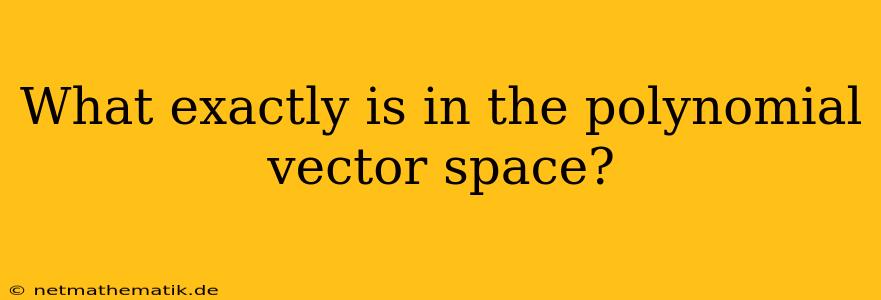The concept of a vector space might seem abstract at first, but it's a fundamental concept in mathematics, particularly in linear algebra. One intriguing application of vector spaces is in the study of polynomials. What exactly is in the polynomial vector space? Let's delve into this intriguing mathematical realm.
The Essence of Vector Spaces
Before exploring the polynomial vector space, let's understand what a vector space is in general. A vector space is a set of objects, called vectors, along with two operations:
- Addition: You can add any two vectors in the space and the result is also a vector within that space.
- Scalar Multiplication: You can multiply any vector by a scalar (a number) and the result is also a vector within that space.
These operations must satisfy certain axioms, ensuring that vector spaces behave as expected. These axioms include closure under addition and scalar multiplication, associativity, commutativity, the existence of a zero vector and additive inverses, and distributivity.
The Polynomial Vector Space: A Space of Expressions
Now, let's focus on the polynomial vector space. It's a specific type of vector space where the vectors are polynomials. A polynomial is an expression consisting of variables and coefficients, connected by addition, subtraction, and multiplication, where the exponents of the variables are non-negative integers.
Examples of polynomials:
- 3x² + 2x - 1
- 5x⁴ + 7x³ - 2x² + 9
- x⁵ - 4x + 12
The polynomial vector space is defined as follows:
Definition: The set of all polynomials with coefficients in a field (e.g., the real numbers, the complex numbers) forms a vector space under the operations of polynomial addition and scalar multiplication.
Addition of Polynomials
Adding polynomials involves combining like terms. For example, if we have two polynomials:
- p(x) = 2x² + 3x - 1
- q(x) = x³ - 5x + 2
Their sum, p(x) + q(x), is:
- p(x) + q(x) = x³ + 2x² - 2x + 1
Scalar Multiplication of Polynomials
Scalar multiplication involves multiplying each term of a polynomial by a scalar. For example, if we have the polynomial:
- p(x) = 2x² + 3x - 1
And we multiply it by the scalar 4, we get:
- 4p(x) = 8x² + 12x - 4
Exploring the Structure of the Polynomial Vector Space
The polynomial vector space has a rich structure, and its elements can be classified based on different characteristics. Let's explore some key aspects:
Degree of a Polynomial
The degree of a polynomial is the highest power of the variable in the expression. For example, the polynomial:
- 3x² + 2x - 1
Has a degree of 2, because the highest power of 'x' is 2. Polynomials can be categorized by their degrees:
- Constant Polynomials: Degree 0 (e.g., 5)
- Linear Polynomials: Degree 1 (e.g., 2x + 3)
- Quadratic Polynomials: Degree 2 (e.g., 3x² - 2x + 1)
- Cubic Polynomials: Degree 3 (e.g., x³ + 2x² - 5x + 4)
Basis and Dimension
Just like in any other vector space, the polynomial vector space has a basis, which is a set of linearly independent vectors that span the entire space. The set of monomials (polynomials with only one term) can form a basis for the polynomial vector space.
For example, the set {1, x, x², x³, ...} forms a basis for the vector space of all polynomials with real coefficients. The dimension of a vector space is the number of vectors in a basis. Therefore, the vector space of all polynomials with real coefficients is infinite-dimensional because its basis contains an infinite number of monomials.
Applications of the Polynomial Vector Space
The polynomial vector space has significant applications in various fields:
Linear Algebra and Calculus
The concept of a polynomial vector space is central to linear algebra, where it facilitates the analysis of linear transformations and the solution of systems of equations. In calculus, polynomials are often used to approximate functions and model phenomena.
Signal Processing and Control Theory
Polynomials play a crucial role in signal processing and control theory. They are used to represent signals, design filters, and analyze the stability of systems.
Computer Science and Engineering
In computer science and engineering, polynomials are used in algorithms, numerical analysis, and the development of software for various applications.
Conclusion
The polynomial vector space is a powerful tool in mathematics, providing a framework for understanding and manipulating polynomials. Its structure, with elements classified by their degree, allows for a deeper analysis of polynomial expressions. Its applications extend to numerous fields, highlighting its significance in various scientific and technological endeavors. Exploring this space helps unravel the rich tapestry of mathematical concepts and their connections to the real world.
